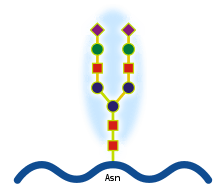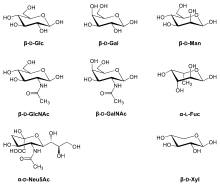Glycoprotein
Glycoproteins are proteins which contain oligosaccharide chains (glycans) covalently attached to amino acid side-chains. The carbohydrate is attached to the protein in a cotranslational or posttranslational modification. This process is known as glycosylation. Secreted extracellular proteins are often glycosylated.

In proteins that have segments extending extracellularly, the extracellular segments are also often glycosylated. Glycoproteins are also often important integral membrane proteins, where they play a role in cell–cell interactions. It is important to distinguish endoplasmic reticulum-based glycosylation of the secretory system from reversible cytosolic-nuclear glycosylation. Glycoproteins of the cytosol and nucleus can be modified through the reversible addition of a single GlcNAc residue that is considered reciprocal to phosphorylation and the functions of these are likely to be additional regulatory mechanism that controls phosphorylation-based signalling.[2] In contrast, classical secretory glycosylation can be structurally essential. For example, inhibition of asparagine-linked, i.e. N-linked, glycosylation can prevent proper glycoprotein folding and full inhibition can be toxic to an individual cell. In contrast, perturbation of glycan processing (enzymatic removal/addition of carbohydrate residues to the glycan), which occurs in both the endoplasmic reticulum and Golgi apparatus, is dispensable for isolated cells (as evidence by survival with glycosides inhibitors) but can lead to human disease (congenital disorders of glycosylation) and can be lethal in animal models. It is therefore likely that the fine processing of glycans is important for endogenous functionality, such as cell trafficking, but that this is likely to have been secondary to its role in host-pathogen interactions. A famous example of this latter effect is the ABO blood group system.
Glycosylation is also known to occur on nucleocytoplasmic proteins in the form of O-GlcNAc.[3]
Types of glycosylation
There are several types of glycosylation, although the first two are the most common.
- In N-glycosylation, sugars are attached to nitrogen, typically on the amide side-chain of asparagine.
- In O-glycosylation, sugars are attached to oxygen, typically on serine or threonine, but also on tyrosine or non-canonical amino acids such as hydroxylysine & hydroxyproline.
- In P-glycosylation, sugars are attached to phosphorus on a phosphoserine.
- In C-glycosylation, sugars are attached directly to carbon, such as in the addition of mannose to tryptophan.
- In S-glycosylation, a beta-GlcNAc is attached to the sulfur atom of a cysteine residue.[4]
- In glypiation, a GPI glycolipid is attached to the C-terminus of a polypeptide, serving as a membrane anchor.
- In glycation, also known as non-enzymatic glycosylation, sugars are covalently bonded to a protein or lipid molecule, without the controlling action of an enzyme, but through a Maillard reaction.
Monosaccharides

Monosaccharides commonly found in eukaryotic glycoproteins include:[5]:526
| Sugar | Type | Abbreviation |
|---|---|---|
| β-D-Glucose | Hexose | Glc |
| β-D-Galactose | Hexose | Gal |
| β-D-Mannose | Hexose | Man |
| α-L-Fucose | Deoxyhexose | Fuc |
| N-Acetylgalactosamine | Aminohexose | GalNAc |
| N-Acetylglucosamine | Aminohexose | GlcNAc |
| N-Acetylneuraminic acid | Aminononulosonic acid (Sialic acid) |
NeuNAc |
| Xylose | Pentose | Xyl |
The sugar group(s) can assist in protein folding, improve proteins' stability and are involved in cell signalling.
Examples
One example of glycoproteins found in the body is mucins, which are secreted in the mucus of the respiratory and digestive tracts. The sugars when attached to mucins give them considerable water-holding capacity and also make them resistant to proteolysis by digestive enzymes.
Glycoproteins are important for white blood cell recognition. Examples of glycoproteins in the immune system are:
- molecules such as antibodies (immunoglobulins), which interact directly with antigens.
- molecules of the major histocompatibility complex (or MHC), which are expressed on the surface of cells and interact with T cells as part of the adaptive immune response.
- sialyl Lewis X antigen on the surface of leukocytes.
H antigen of the ABO blood compatibility antigens. Other examples of glycoproteins include:
- gonadotropins (luteinizing hormone a follicle-stimulating hormone)
- glycoprotein IIb/IIIa, an integrin found on platelets that is required for normal platelet aggregation and adherence to the endothelium.
- components of the zona pellucida, which surrounds the oocyte, and is important for sperm-egg interaction.
- structural glycoproteins, which occur in connective tissue. These help bind together the fibers, cells, and ground substance of connective tissue. They may also help components of the tissue bind to inorganic substances, such as calcium in bone.
- Glycoprotein-41 (gp41) and glycoprotein-120 (gp120) are HIV viral coat proteins.
Soluble glycoproteins often show a high viscosity, for example, in egg white and blood plasma.
- Miraculin, is a glycoprotein extracted from Synsepalum dulcificum a berry which alters human tongue receptors to recognize sour foods as sweet.[7]
Variable surface glycoproteins allow the sleeping sickness Trypanosoma parasite to escape the immune response of the host.
The viral spike of the human immunodeficiency virus is heavily glycosylated.[8] Approximately half the mass of the spike is glycosylation and the glycans act to limit antibody recognition as the glycans are assembled by the host cell and so are largely 'self'. Over time, some patients can evolve antibodies to recognise the HIV glycans and almost all so-called 'broadly neutralising antibodies (bnAbs) recognise some glycans. This is possible mainly because the unusually high density of glycans hinders normal glycan maturation and they are therefore trapped in the premature, high-mannose, state.[9][10] This provides a window for immune recognition. In addition, as these glycans are much less variable than the underlying protein, they have emerged as promising targets for vaccine design.[11]
Hormones
Hormones that are glycoproteins include:
Functions
| Function | Glycoproteins |
|---|---|
| Structural molecule | Collagens |
| Lubricant and protective agent | Mucins |
| Transport molecule | Transferrin, ceruloplasmin |
| Immunologic molecule | Immunoglobulins,[12] histocompatibility antigens |
| Hormone | Human chorionic gonadotropin (HCG), thyroid-stimulating hormone (TSH) |
| Enzyme | Various, e.g., alkaline phosphatase, patatin |
| Cell attachment-recognition site | Various proteins involved in cell–cell (e.g., sperm–oocyte), virus–cell, bacterium–cell, and hormone–cell interactions |
| Antifreeze protein | Certain plasma proteins of coldwater fish |
| Interact with specific carbohydrates | Lectins, selectins (cell adhesion lectins), antibodies |
| Receptor | Various proteins involved in hormone and drug action |
| Affect folding of certain proteins | Calnexin, calreticulin |
| Regulation of development | Notch and its analogs, key proteins in development |
| Hemostasis (and thrombosis) | Specific glycoproteins on the surface membranes of platelets |
Analysis
A variety of methods used in detection, purification, and structural analysis of glycoproteins are[5]:525[12][13]
| Method | Use |
|---|---|
| Periodic acid-Schiff stain | Detects glycoproteins as pink bands after electrophoretic separation. |
| Incubation of cultured cells with glycoproteins as radioactive decay bands | Leads to detection of a radioactive sugar after electrophoretic separation. |
| Treatment with appropriate endo- or exoglycosidase or phospholipases | Resultant shifts in electrophoretic migration help distinguish among proteins with N-glycan, O-glycan, or GPI linkages and also between high mannose and complex N-glycans. |
| Agarose-lectin column chromatography, lectin affinity chromatography | To purify glycoproteins or glycopeptides that bind the particular lectin used. |
| Lectin affinity electrophoresis | Resultant shifts in electrophoretic migration help distinguish and characterize glycoforms, i.e. variants of a glycoprotein differing in carbohydrate. |
| Compositional analysis following acid hydrolysis | Identifies sugars that the glycoprotein contains and their stoichiometry. |
| Mass spectrometry | Provides information on molecular mass, composition, sequence, and sometimes branching of a glycan chain. It can also be used for site-specific glycosylation profiling.[12] |
| NMR spectroscopy | To identify specific sugars, their sequence, linkages, and the anomeric nature of glycosidic chain. |
| Multi-angle light scattering | In conjunction with size-exclusion chromatography, UV/Vis absorption and differential refractometry, provides information on molecular mass, protein-carbohydrate ratio, aggregation state, size, and sometimes branching of a glycan chain. In conjunction with composition-gradient analysis, analyzes self- and hetero-association to determine binding affinity and stoichiometry with proteins or carbohydrates in solution without labeling. |
| Dual Polarisation Interferometry | Measures the mechanisms underlying the biomolecular interactions, including reaction rates, affinities and associated conformational changes. |
| Methylation (linkage) analysis | To determine linkage between sugars. |
| Amino acid or cDNA sequencing | Determination of amino acid sequence. |
See also
Notes and references
- Ruddock, L. W.; Molinari, M. (2006). "N-glycan processing in ER quality control". Journal of Cell Science. 119 (21): 4373–4380. doi:10.1242/jcs.03225. PMID 17074831.
- Funakoshi Y, Suzuki T (January 2009). "Glycobiology in the cytosol: The bitter side of a sweet world". Biochim. Biophys. Acta. 1790 (2): 81–94. doi:10.1016/j.bbagen.2008.09.009. PMID 18952151.
- Gw, Hart (27 October 2014). "Three Decades of Research on O-GlcNAcylation - A Major Nutrient Sensor That Regulates Signaling, Transcription and Cellular Metabolism". Frontiers in endocrinology. PMID 25386167. Retrieved 1 June 2020.
- Stepper, Judith; Shastri, Shilpa; Loo, Trevor S.; Preston, Joanne C.; Novak, Petr; Man, Petr; Moore, Christopher H.; Havlíček, Vladimír; Patchett, Mark L. (18 January 2011). "CysteineS-glycosylation, a new post-translational modification found in glycopeptide bacteriocins". FEBS Letters. 585 (4): 645–650. doi:10.1016/j.febslet.2011.01.023. ISSN 0014-5793. PMID 21251913.
- Robert K. Murray, Daryl K. Granner & Victor W. Rodwell: "Harper's Illustrated Biochemistry 27th Ed.", McGraw–Hill, 2006
- Glycan classification SIGMA
- Theerasilp S, Kurihara Y (August 1988). "Complete purification and characterization of the taste-modifying protein, miraculin, from miracle fruit". J. Biol. Chem. 263 (23): 11536–9. PMID 3403544.
- Pritchard, Laura K.; Vasiljevic, Snezana; Ozorowski, Gabriel; Seabright, Gemma E.; Cupo, Albert; Ringe, Rajesh; Kim, Helen J.; Sanders, Rogier W.; Doores, Katie J. (16 June 2015). "Structural Constraints Determine the Glycosylation of HIV-1 Envelope Trimers". Cell Reports. 11 (10): 1604–1613. doi:10.1016/j.celrep.2015.05.017. ISSN 2211-1247. PMC 4555872. PMID 26051934.
- Pritchard, Laura K.; Spencer, Daniel I. R.; Royle, Louise; Bonomelli, Camille; Seabright, Gemma E.; Behrens, Anna-Janina; Kulp, Daniel W.; Menis, Sergey; Krumm, Stefanie A. (24 June 2015). "Glycan clustering stabilizes the mannose patch of HIV-1 and preserves vulnerability to broadly neutralizing antibodies". Nature Communications. 6: 7479. Bibcode:2015NatCo...6.7479P. doi:10.1038/ncomms8479. PMC 4500839. PMID 26105115.
- Behrens, Anna-Janina; Vasiljevic, Snezana; Pritchard, Laura K.; Harvey, David J.; Andev, Rajinder S.; Krumm, Stefanie A.; Struwe, Weston B.; Cupo, Albert; Kumar, Abhinav (10 March 2016). "Composition and Antigenic Effects of Individual Glycan Sites of a Trimeric HIV-1 Envelope Glycoprotein". Cell Reports. 14 (11): 2695–2706. doi:10.1016/j.celrep.2016.02.058. ISSN 2211-1247. PMC 4805854. PMID 26972002.
- Crispin, Max; Doores, Katie J (1 April 2015). "Targeting host-derived glycans on enveloped viruses for antibody-based vaccine design". Current Opinion in Virology. Viral pathogenesis • Preventive and therapeutic vaccines. 11: 63–69. doi:10.1016/j.coviro.2015.02.002. PMC 4827424. PMID 25747313.
- Maverakis E, Kim K, Shimoda M, Gershwin M, Patel F, Wilken R, Raychaudhuri S, Ruhaak LR, Lebrilla CB (2015). "Glycans in the immune system and The Altered Glycan Theory of Autoimmunity". J Autoimmun. 57 (6): 1–13. doi:10.1016/j.jaut.2014.12.002. PMC 4340844. PMID 25578468.
- Dell A (2001). "Glycoprotein Structure Determination by Mass Spectrometry". Science. 291 (5512): 2351–2356. Bibcode:2001Sci...291.2351D. doi:10.1126/science.1058890. ISSN 0036-8075. PMID 11269315.
External links
- Glycan Recognizing Proteins
- Structure of Glycoprotein and Carbohydrate Chain – Home Page for Learning Environmental Chemistry
- Biochemistry 5thE 11.3. Carbohydrates Can Be Attached to Proteins to Form Glycoproteins
- Carbohydrate Chemistry and Glycobiology: A Web Tour SPECIAL WeB SUPPLEMENT Science 23 March 2001 Vol 291, Issue 5512, Pages 2263–2502
- Glycoproteins at the US National Library of Medicine Medical Subject Headings (MeSH)
- Emanual Maverakis; et al. "Glycans in the immune system and The Altered Glycan Theory of Autoimmunity" (PDF).
- Biological Importance of the glycosylation of a protein